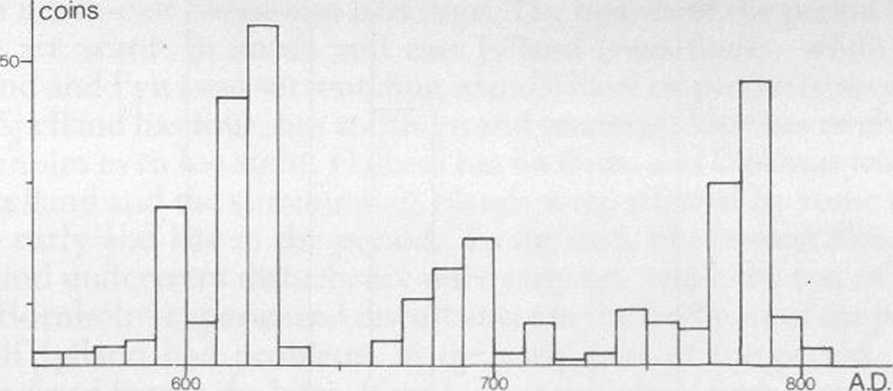83 (120)
160 The Viking Age in Denmark

Figurc 50 Distribution of Arabie coins in a late tenth-century silver-hoard from Yaalse, island of Falstcr
transactions within the Islamie world, the largest Russian hoards do not exceed forty kgs, while the Scandinavian finds make up, at most, one-fifth of this, or eight kgs of silver. Furthermore, the few Arabie coins in western Europę almost all stem from the early tenth century, corresponding to the noted peak and subsequent to the raids. Finally, to judge by the number of Arabie coins found in Scandinavia, the ninth-century types make up only 10 per cent of the total amount, and the peak of the early ninth century may have been less prominent here than in Russia.44 This is seen also from the silver curve above for Denmark, though it should be remembered that the coins were morę commonly turned into artefacts in the ninth than in the tenth century.
In Fig. 43 we give the relative percentages of Arabie, German, English and Nordic coins for the Danish hoards of the period 900 to 1040. It clearly shows how drastically the percentages of Arabie coins were dropping in the middle of the tenth century, the period of depression of the silver stock. We have already discussed some of the conseąuences of this decline, which corresponds well with west, and especially south-west, Russia. Denmark may thus have received the last Arabie coins through Poland, an area with intensive contacts with southernmost Scandinavia by the late tenth century.
The mid-tenth century saw other changes also in the composition of the hoards. In a study ofthe eastern Danish provinces, and particularly of Skane, it has been shown that the weight of minted silver in the finds, vis-a-vis jewellery, was rising drastically at this time, to reach almost 100 per cent after 1000 A.D. (Fig. 53).45 This demonstrates how investment in trinkets gave way to silver cash, a much morę flexible means of exchange, and how transactions involving coins were fast becoming a day-to-day phenomenon for still larger parts of the population. The late tenth century also has the first mass-produced local coinage. A parallel, though slightly earlier, development involves hack-silver, the percentage of which, vis-a-vis the unbroken artefacts, is rising at the same time as the single pieces are becoming smaller.46
The disappearance of the Arabie flow of silver was also a finał
departurc from an undeveloped economy, based on barter, where smaller exchanges did not involve coins and wherc larger transactions were probably often of the naturę of gift-exchanges, wholc artefacts being used as a means of exchange.47 It is hardly an accident that the few pure coin hoards of the tenth century cluster in the south-western part of Denmark, with its morę developed economic institutions, including towns.48 On the other hand, finds dominated by whole artefacts, and usually with few or no coins, are most common on the Sjaelland island group, a wealthy area, as we have seen, with a Iow
600-n
coins
400-200-
,—n rn—rfl JL
700

Figurę 51 Distribution of (Arabie) coins in an early ninth-ccntury hoard from Umm-Hajarah, north-cast Syria
800 AD
Figurę 52 Distribution of (Arabie) coins in a late ninth-century hoard from Susa, south-west Persia
Wyszukiwarka
Podobne podstrony:
80 (129) 154 The Viking Age in Denmark Figurc 44 Distribution of Arabie coins in a sam ple of north-
82 (123) 158 The Viking Age in Denmark Figurc 48 Distribution of Arabie coins in an carly tenth-cent
58 (195) 110 The Viking Age in Denmark Platę VI. Sample from late tenth-century silver-hoard at Taru
81 (117) 156 The Viking Age in Denmark Figurę 46 Distribution of Arabie coins in a samplc of castcrn
63 (170) 120 The Viking Age in Denmark % Platę XVI Pagc with illustration of an English manuscript f
66 (160) 126 The Viking Age in Denmark have becn fouhd (Figs 32-3).7 They stem from thc same provinc
97 (83) 188 The Viking Age in Denmark C. Fyn, etc. Skovmand 1942II.A numbers: 26 i b, 271 b, 28 i b,
57 (213) 108 The Viking Age in Denmark Platę IV. Silvcr and copper dccorated spurs, length about 21
60 (189) 114 The Viking Age in Denmark Platc X. Ship-sctting and runestonc (on smali mound) at Glave
62 (179) 118 The Viking Age in Denmark Plato XIV. Iron tools from a tenth-ccntury hoard atTjclc, nor
64 (171) 122 The Viking Age in Denmark Figurc 30 Distribution of wealth in three cemeteries as measu
68 (153) 130 The Viking Age in Denmark two tortoise bucklcs to reprcsent wornen of high standing, th
69 (151) 132 The Viking Age in Denmark heavy cavalry burials, fincr wcapon graves of thc simple type
70 (150) 134 The Viking Age in Denmark cemetcry at Lejre on Sjaelland a dccapitatcd and ticd man was
74 (134) 142 The Viking Age in Denmark 5C~ł silver 800 900 kxx) A.D. Figurę 37 Fluctuations in che r
75 (129) 144 The Viking Age in Denmark Figurę 38 Average weight ofthesilver-hoardsofthe period 900 t
27 (504) 48 The Viking Age in Denmark Europcan meteorological data for earlier per
29 (466) 52 The Viking Age in Denmark We have already mentioned the expansion of grasses, and it is
30 (454) 54 The Viking Age in Denmark touch, so the political developmcnt we have described in previ
więcej podobnych podstron